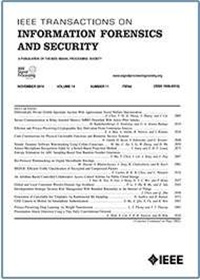重新审视基于预测的最小熵估计:迈向可解释性、可靠性和适用性
IF 8
1区 计算机科学
Q1 COMPUTER SCIENCE, THEORY & METHODS
IEEE Transactions on Information Forensics and Security
Pub Date : 2025-09-08
DOI:10.1109/TIFS.2025.3607168
引用次数: 0
摘要
基于预测的最小熵估计方法,也称为预测器,是评估熵源安全性的重要工具。根据NIST SP 800-90B (90B)的建议,这些方法通过预测熵源的输出来估计最小熵。由于它们的计算效率,大量的研究集中在提高预测器的准确性上,包括基于深度神经网络(dnn)的方法。然而,对其可解释性、可靠性和适用性的担忧仍然存在,特别是对于基于dnn的预测器。在本文中,我们首先指出了现有基于预测方法的主要缺陷,包括基于90B和基于dnn的预测方法,这些方法导致估计不可靠,并且在不同熵源之间的适应性差。为了提高可靠性,我们对预测器输出分布进行建模,并修改局部可预测性度量,以产生具有相关置信度的更稳定的估计。为了提高基于dnn的预测器在熵估计中的可解释性,我们提供了第一个将神经网络优化目标与最小熵联系起来的理论分析,阐明了不同架构的适用性和可学习性。我们进一步揭示了现有方法在时变源下的不适用性,并提出了一种结合在线学习,变化检测和贝叶斯优化的动态模型更新的新估计框架。实验结果表明,我们的方法在可靠性和适用性方面优于现有方法,特别是在处理时变源时。本文章由计算机程序翻译,如有差异,请以英文原文为准。
Revisiting Prediction-Based Min-Entropy Estimation: Toward Interpretability, Reliability, and Applicability
Prediction-based min-entropy estimation methods, also known as predictors, are essential tools for assessing the security of entropy sources. As recommended in NIST SP 800-90B (90B), these methods estimate min-entropy by forecasting the outputs of entropy sources. Owing to their computational efficiency, considerable research has focused on enhancing the accuracy of predictors, including approaches based on deep neural networks (DNNs). However, concerns remain about their interpretability, reliability, and applicability, particularly for DNN-based predictors. In this paper, we first identify key deficiencies in existing prediction-based methods, including those in 90B and DNN-based predictors, which lead to unreliable estimates and poor adaptability across diverse entropy sources. To improve reliability, we model the predictor output distribution and revise the local predictability metric to produce more stable estimates with associated confidence levels. To enhance the interpretability of DNN-based predictors in entropy estimation, we provide the first theoretical analysis linking neural network optimization objectives to min-entropy, clarifying the suitability and learnability of different architectures. We further reveal the inapplicability of existing methods under time-varying sources and propose a new estimation framework that combines online learning, change detection, and Bayesian optimization for dynamic model updates. The experimental results demonstrate that our methods surpass existing approaches in terms of reliability and applicability, especially when dealing with time-varying sources.
求助全文
通过发布文献求助,成功后即可免费获取论文全文。
去求助
来源期刊

IEEE Transactions on Information Forensics and Security
工程技术-工程:电子与电气
CiteScore
14.40
自引率
7.40%
发文量
234
审稿时长
6.5 months
期刊介绍:
The IEEE Transactions on Information Forensics and Security covers the sciences, technologies, and applications relating to information forensics, information security, biometrics, surveillance and systems applications that incorporate these features
 求助内容:
求助内容: 应助结果提醒方式:
应助结果提醒方式:


